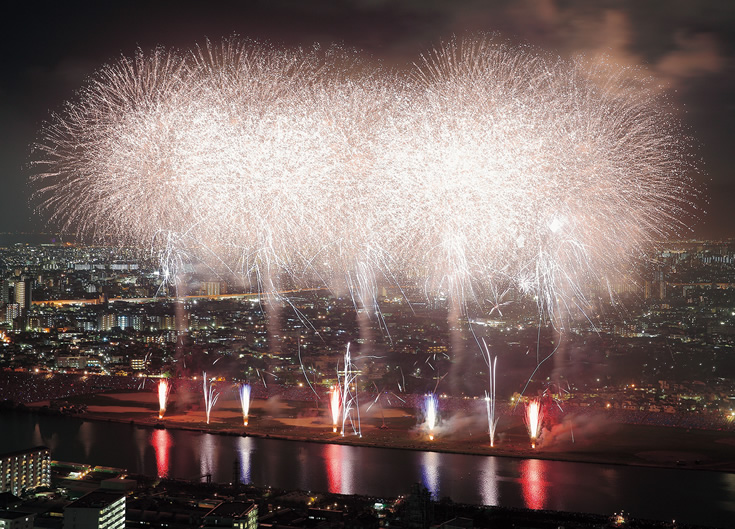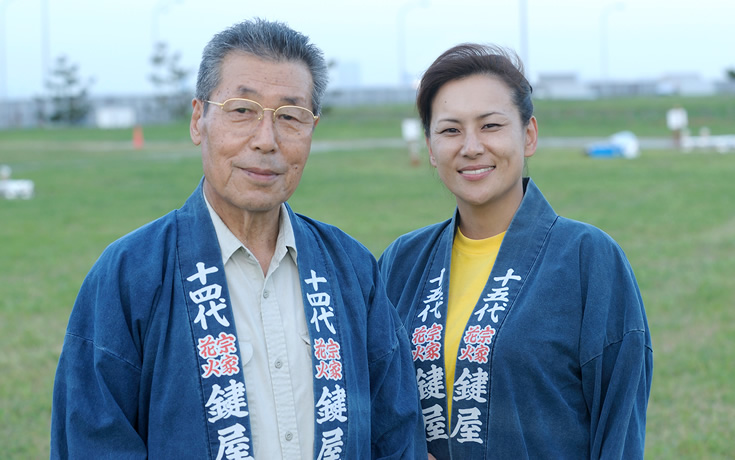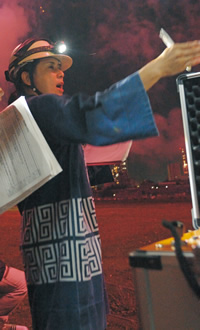niponica is a web magazine that introduces modern Japan to people all over the world.
2018 NO.24
Japanese Festivals Throughout the Year

Supporting Festival Excitement
People with various skills and interests are involved in every festival. Have a look behind the scenes, and meet some of the people who help make festivals happen.

Scene from a display organized by Kagiya for the Edogawa Fireworks Festival in Tokyo.
Photo courtesy of Edogawa Fireworks Festival Execution Committee.
Harnessing the energy of experts to electrify the night
With sparks flying all around, Amano directs the order and timing of the rocket launches. Photo: Takaoka Kunihiko
Fireworks paint tableaus in the night sky every summer in Japan. In the old days, pyrotechnic artisans wrapped explosive powder and chemicals in washi paper. Today, the wow factor depends on the producer’s skills with launch timing and visual effects.
The fireworks company Kagiya, a family business, has been around for more than 300 years. Amano Akiko, the former owner’s second daughter, was inspired by her father. “I always wanted to be cool like him, in the thick of the action.” What started as a whim, later developed into a serious ambition.
Her father knew she wanted to join the company, but he objected to her idea. She recalls: “I told him I was going to work in a different fireworks factory, where we didn’t know anyone. I knew I had to gain experience and knowledge if I was going to get into manufacturing fireworks and staging events. Dad had wanted me to take over just the business side of things. It took more than six months to persuade him.”
Back then, there wasn’t one woman in Japan working directly with explosive powder. Still, Amano knew she could succeed—if she could get experience in fireworks manufacturing, a risky process requiring extreme caution. Then she could earn the respect of the self-assured men at Kagiya and bring out the best in them.
So she studied the latest manufacturing processes and techniques, and then in the year 2000 she took over as the 15th owner of Kagiya. Today, she is at the heart of the action when staging events. She designs fireworks, orders supplies, schedules launch sequences, and chooses audio effects.
For a big event she manages about 100 staff, watching the weather and the audience’s mood. At some events she issues almost 300 launch orders in an hour. With her on each Kagiya team there are usually about seven other women, and the Kagiya sense of mission is stronger than ever.
“For centuries spectators have found fireworks exhilarating. Nowadays, with new technology every year, shows are more exciting than ever. Yet we aim to do more—not just with technology, but with timing. Embracing the traditional Japanese aesthetics of ma (dramatic pauses) and yoin (lingering feelings), we try to take spectators’ breath away as they wait for the next moment.”
In old Edo, fireworks were used as a prayer for the repose of souls lost in earthquakes, floods and other disasters. Faithful to that tradition, Amano will always remember the advice of her predecessor, her father: “Never forget the awesome power of fire.”

As pyrotechnics producer, Amano Akiko (10th from left) organizes big fireworks events. Here, she is pictured with engineers employed by her company, Kagiya.

In admiration of her father, Amano Osamu, she set out to become a pyrotechnic artisan like him.






